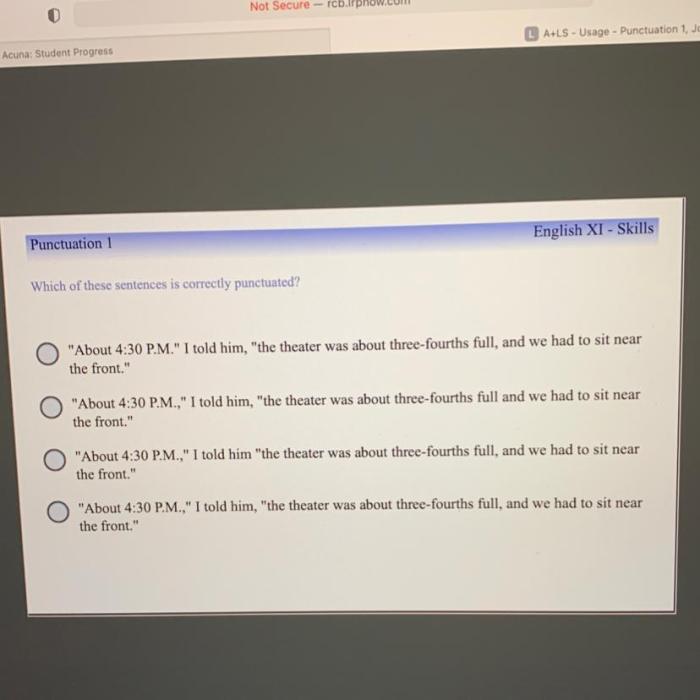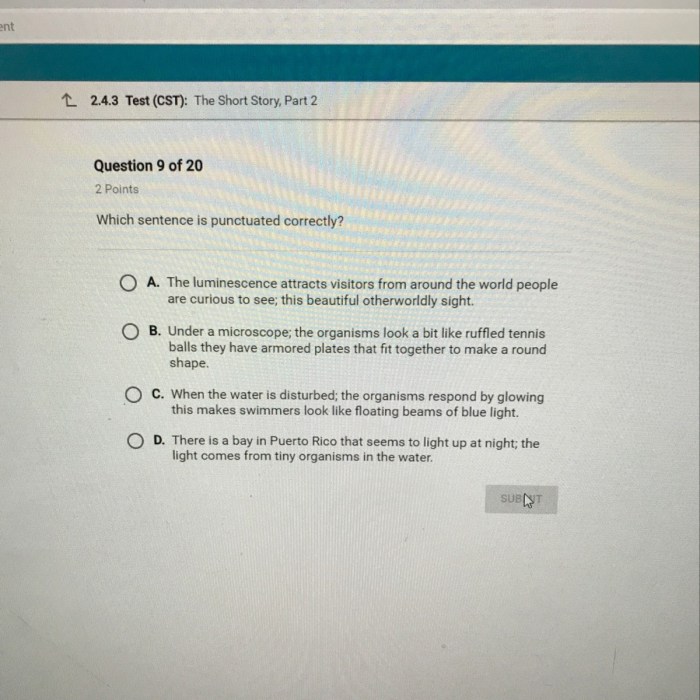In which of these sentences is the list correctly punctuated? This question delves into the intricacies of punctuation, exploring the nuances of list construction and the impact of proper punctuation on clarity and readability.
Mastering the art of list punctuation empowers writers to convey information effectively, ensuring that their messages are received with precision and comprehension. This comprehensive guide unravels the complexities of list punctuation, providing a roadmap to error-free and impactful communication.
Punctuation in Lists: In Which Of These Sentences Is The List Correctly Punctuated

Lists are a common way to organize information. They can be used to present a series of items, steps, or ideas in a clear and concise manner. However, it is important to use correct punctuation when writing lists. Otherwise, the list may be difficult to read and understand.
Identifying Punctuation Errors
There are a few common punctuation errors that people make when writing lists. These errors include:
- Using commas after the last item in a list
- Using semicolons instead of commas to separate items in a list
- Using dashes instead of commas or semicolons to separate items in a list
- Not using any punctuation at all to separate items in a list
These errors can make it difficult to read and understand a list. For example, the following list is difficult to read because it uses commas after the last item in the list:
I need to buy the following items at the store:
- Milk
- Eggs
- Bread,
The following list is also difficult to read because it uses semicolons instead of commas to separate the items in the list:
I need to buy the following items at the store:
- Milk
- Eggs;
- Bread;
The following list is also difficult to read because it uses dashes instead of commas or semicolons to separate the items in the list:
I need to buy the following items at the store:
- Milk
- Eggs
- – Bread
The following list is also difficult to read because it does not use any punctuation at all to separate the items in the list:
I need to buy the following items at the store:
- Milk
- Eggs
- Bread
Analyzing Punctuation Usage
When writing a list, it is important to use the correct punctuation to separate the items in the list. The most common punctuation marks used to separate items in a list are commas, semicolons, and dashes.
Commas are the most common punctuation mark used to separate items in a list. Commas are used to separate items that are in a series. For example:
I need to buy the following items at the store:
- Milk
- Eggs
- Bread
Semicolons are used to separate items in a list that are longer or more complex. Semicolons are also used to separate items in a list that contain commas. For example:
I need to buy the following items at the store:
- Milk
- Eggs, which are on sale this week;
- Bread, which I need for sandwiches.
Dashes are used to separate items in a list that are emphatic or that are being contrasted with each other. For example:
I need to buy the following items at the store:
- Milk
- Eggs
- – Bread, which is my favorite food
Punctuation Styles and Variations, In which of these sentences is the list correctly punctuated
There are different punctuation styles that can be used for lists. The most common punctuation style is the Oxford comma style. The Oxford comma style is a style of punctuation that uses a comma before the last item in a list.
For example:
I need to buy the following items at the store:
- Milk
- Eggs
- Bread,
The Oxford comma style is not required in all writing styles. However, it is a good idea to use the Oxford comma style when writing lists that are long or complex.
Another punctuation style that can be used for lists is the Chicago comma style. The Chicago comma style is a style of punctuation that does not use a comma before the last item in a list. For example:
I need to buy the following items at the store:
- Milk
- Eggs
- Bread
The Chicago comma style is more common in American English than in British English.
Best Practices for List Punctuation
When writing a list, it is important to use the correct punctuation to separate the items in the list. The most common punctuation marks used to separate items in a list are commas, semicolons, and dashes. The Oxford comma style is a style of punctuation that uses a comma before the last item in a list.
The Chicago comma style is a style of punctuation that does not use a comma before the last item in a list.
Here are some best practices for list punctuation:
- Use commas to separate items in a list that are in a series.
- Use semicolons to separate items in a list that are longer or more complex.
- Use dashes to separate items in a list that are emphatic or that are being contrasted with each other.
- Use the Oxford comma style when writing lists that are long or complex.
- Use the Chicago comma style when writing lists that are short and simple.
FAQ Compilation
What are the most common punctuation errors in lists?
Missing commas, incorrect use of semicolons, and inconsistent punctuation between items.
How can I avoid punctuation errors in lists?
Follow the rules for comma usage, use semicolons correctly, and maintain consistency throughout the list.
What is the best punctuation style for lists?
The most common and effective style is using commas to separate list items.

